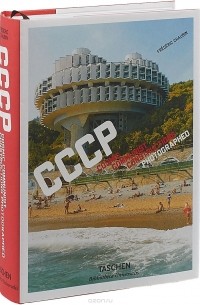
Автор
Frederic Chaubin – лучшие книги
- 4 издания на 2 языках
По популярности
-
CCCP: Cosmic Communist Constructions Photographed Frederic Chaubin
ISBN: 9783836565059 Год издания: 2017 Издательство: Taschen Язык: Английский Elected the architectural book of the year by the International Artbook and Film Festival in Perpignan, France, Frederic Chaubin's Cosmic Communist Constructions Photographed explores 90 buildings in 14 former Soviet Republics. Each of these structures expresses what Chaubin considers the fourth age of Soviet architecture, an unknown burgeoning that took place from 1970 until 1990.Contrary to the 1920s and 1950s, no "school" or main trend emerges here. These buildings represent a chaotic impulse brought about by a decaying system. Taking advantage of the collapsing monolithic structure, architects went far beyond modernism, going back to the roots or freely innovating. Some of the daring ones completed projects that the Constructivists would have dreamt of (Druzhba Sanatorium, Yalta), others expressed their imagination in an expressionist way (Palace of Weddings, Tbilisi). A summer camp, inspired by sketches of a prototype lunar base, lays claim to Suprematist influence (Prometheus youth camp, Bogatyr). Then comes the "speaking architecture" widespread in the last years of the USSR: a crematorium adorned with concrete flames (Crematorium, Kiev), a technological institute with a flying saucer crashed on the roof (Institute of Scientific Research, Kiev), a political center watching you like Big Brother (House of Soviets, Kaliningrad).In their puzzle of styles, their outlandish strategies, these buildings are extraordinary remnants of a collapsing system.In their diversity and local exoticism, they testify both to the vast geography of the USSR and its encroaching end of the Soviet Union, the holes in a widening net. At the same time, they immortalize many of the ideological dreams of the country and its time, from an obsession with the cosmos to the rebirth of identity. -
Stone Age. Ancient Castles of Europe Frederic Chaubin
ISBN: 9783836585019 Год издания: 2021 Издательство: Taschen Castles and fortresses of medieval Europe
Follow photographer Frederic Chaubin as he embarks on a unique, century-spanning journey through Europe. Featuring images of more than 200 buildings in 21 countries, Stone Age presents the history and architecture of the most dramatic medieval castles of the continent in an unprecedented collection.
Building on the success of his foray into Soviet design with CCCP, Chaubin once again documents the afterlife of highly rational structures that seem out of place in a modern-day world. Precursors of Brutalism, these castles value function over form and epitomize the raw materials and shapes that would go on to define so much of architectural history.
Shot on film with a Linhof view camera, the collection is the outcome of five years of travel and investigation. Complete with a practical map and explanatory essay, its castles tell the story of 400 years, unfolding through the feudal Middle Ages into the 15th century.
A photographic study of decay as much as endurance, Stone Age traces the history of some of these singular structures that continue to enchant their audiences today and that occupy a distinct, mystical place in our collective imagination. -
Frederic Chaubin: Cosmic Communist Constructions Photographed Frederic Chaubin
ISBN: 3836525194 Год издания: 2011 Издательство: Taschen Язык: Русский The fourth age of Soviet architecture.
In this volume photographer Frederic Chaubin reveals 90 buildings sited in fourteen former Soviet Republics which express what could be considered as the fourth age of Soviet architecture. They reveal an unexpected rebirth of imagination, an unknown burgeoning that took place from 1970 until 1990. Contrary to the twenties and thirties, no “school” or main trend emerges here. These buildings represent a chaotic impulse brought about by a decaying system. Their diversity announces the end of Soviet Union.
Taking advantage of the collapsing monolithic structure, the holes of the widening net, architects revisited all the chronological periods and styles, going back to the roots or freely innovating. Some of the daring ones completed projects that the Constructivists would have dreamt of (Druzhba sanatorium), others expressed their imagination in an expressionist way (Tbilisi wedding palace). A summer camp, inspired by sketches of a prototype lunar base, lays claim to its suprematist influence (Promethee). Then comes the speaking architecture widespread in the last years of the USSR: a crematorium adorned with concrete flames (Kiev crematorium), a technological institute with a flying saucer crashed on the roof (Kiev institute), a political center watching you like a Big Brother (Kaliningrad House of Soviet). This puzzle of styles testifies to all the ideological dreams of the period, from the obsession with the cosmos to the rebirth of privacy and it also outlines the geography of the USSR, showing how local influences made their exotic twists before bringing the country to its end.


